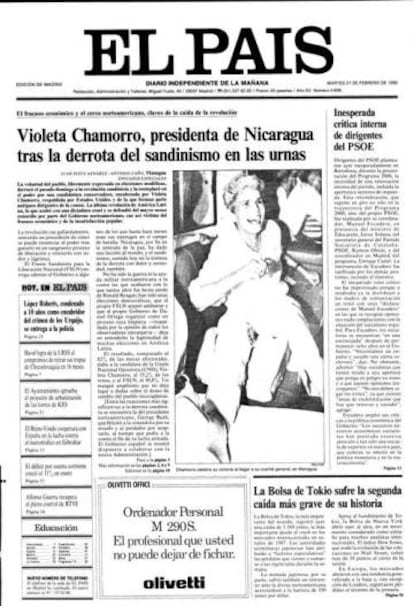From four to zero: Latin America loses its female presidents
With the end of Michelle Bachelet’s term in Chile, women leaders are now absent from the region

The presidential palaces of Latin America are bereft of female presidents. When Chile’s Michelle Bachelet handed responsibilities over to Sebastián Piñera on Sunday, it marked the end of an era when, at one point, up to four women were holding the highest office in their respective countries.
The end of the Bachelet administration, which encompasses two distinct periods – 2006 to 2010 and 2014 to 2018 – is also the end of something bigger: an unprecedented era of political might for women in that part of the world. While Bachelet was in power, Dilma Rousseff was also governing Brazil (2011-2016), Cristina Fernández de Kirchner was in charge of Argentina (2007-2015) and Laura Chinchilla was the president of Costa Rica (2010-2014).
Women will lead their countries again
Lara Blanco, UN Women
The first Latin American woman to be elected to the presidency was Nicaragua’s Violeta Barrios de Chamorro back in 1990, when she defeated Sandinista Front leader Daniel Ortega (who is the current president of the Central American nation.)
She was followed by Panama’s Mireya Moscoso, who held power between 1999 and 2004 – a period of time when the US returned sovereignty of the Panama Canal.
And in 2006 Chileans voted for Michelle Bachelet, the daughter of a general who had been tortured and imprisoned by the Pinochet regime. Her leadership was marked by ups and downs, particularly during her second term, and in between she headed the United Nations women’s rights agency, UN Women.

In 2007 Argentina got a new president, Cristina Fernández de Kirchner, the only woman to have served two consecutive terms after winning again in 2011. Before that, she had been a deputy and a senator during the administration of her husband Néstor Kirchner, who died in 2010.
In Brazil, Dilma Rousseff came to power in October 2010, after holding several portfolios under then-president Luiz Inácio Lula da Silva. She was re-elected in 2014 but was unable to complete her term in office after being impeached in August 2016 over financing irregularities in the public accounts.
Costa Rica also got its first female president in 2010. Laura Chinchilla, a member of the National Liberation Party, a social-democratic group, served until 2014 after having worked as a deputy, minister and vice-president.
Interim presidents
Before them, other women had temporarily assumed power for a variety of reasons. In Argentina, Isabel Martínez de Perón took over between 1974 and 1976 following the death of her husband Juan Domingo Perón, as she had been his vice-president.

In Bolivia, Congress designated Lidia Gueiler as the new president in 1979 following the coup by General Alberto Natushch Busch, who deposed the interim government of Walter Guevara. Gueiler was supposed to hold office until new elections in June of the following year, but before her successor had a chance to take over, a new coup forced Gueiler into exile.
In 1997, Ecuador’s vice-president, Rosalía Arteaga, very briefly took the reins of the country after Abdalá Bucaram was declared “mentally unfit” by Congress. Her term lasted all of three days in the midst of a political chaos that prevented her from forming a government. She made an unsuccessful bid for the presidency in the 1998 elections, and retired from politics after that.
The Caribbean has also had its share of pioneering women politicians. Ertha Pascal-Trouillot, a Haiti Supreme Court justice, became the interim president on March 10, 1990 after General Prosper Avril stepped down following a week of public protests. Pascal-Trouillot called a fresh election and 11 months later she handed the baton to Jean Bertrand Aristide. And in Guyana, Janet Rosenberg was the prime minister from 1997 to 1999 after her husband Cheddi Jagan died.
From four to zero
The question now is, when will Latin America get its next generation of women presidents? According to UN Women, there are still differences in the average man-to-woman ratios inside the world’s parliaments. In June 2017, 11 Latin American countries had 30% female representatives in parliament, and only Bolivia had achieved gender parity, with 53.1% of women in its legislature.
“There is growing evidence that female leadership in political and decision-making processes improves these processes,” said sources at the institution.
In an interview on occasion of International Women’s Day last week, the agency’s adjunct regional director for the Americas and the Caribbean, Lara Blanco, lamented the current lack of female presidents but expressed confidence in the future “because there are growing numbers of women participating in politics,” she told the Efe news agency. “Women will lead their countries again.”
English version by Susana Urra.
Tu suscripción se está usando en otro dispositivo
¿Quieres añadir otro usuario a tu suscripción?
Si continúas leyendo en este dispositivo, no se podrá leer en el otro.
FlechaTu suscripción se está usando en otro dispositivo y solo puedes acceder a EL PAÍS desde un dispositivo a la vez.
Si quieres compartir tu cuenta, cambia tu suscripción a la modalidad Premium, así podrás añadir otro usuario. Cada uno accederá con su propia cuenta de email, lo que os permitirá personalizar vuestra experiencia en EL PAÍS.
¿Tienes una suscripción de empresa? Accede aquí para contratar más cuentas.
En el caso de no saber quién está usando tu cuenta, te recomendamos cambiar tu contraseña aquí.
Si decides continuar compartiendo tu cuenta, este mensaje se mostrará en tu dispositivo y en el de la otra persona que está usando tu cuenta de forma indefinida, afectando a tu experiencia de lectura. Puedes consultar aquí los términos y condiciones de la suscripción digital.
More information
Archived In
Últimas noticias
Maduro pleads not guilty before the federal court in New York: ‘I am still the president of Venezuela’
A new test can detect Alzheimer’s from a finger prick
UN team enters Sudanese city of El Fasher after paramilitary massacre: ‘It’s like a ghost town’
A recipe for resistance: Indigenous peoples politicize their struggles from the kitchen
Most viewed
- Gilles Lipovetsky: ‘If you want to live better and fall in love, take Prozac, don’t look to philosophy’
- Alain Aspect, Nobel laureate in physics: ‘Einstein was so smart that he would have had to recognize quantum entanglement’
- Alvin Hellerstein, a 92-year-old judge appointed by Bill Clinton, to preside over Maduro’s trial in New York
- Why oil has been at the center of Venezuela-US conflicts for decades
- Cuba confirms death of 32 of its citizens in the US attack against Venezuela











































